|
|
|
RAF Chipping Warden
RAF Chipping Warden was situated 6 miles North East of Banbury in Oxfordshire. The airfield opened in 1941 as a Bomber Command Operational Training Unit.
The airfield closed in 1946. Today the hangers and some other buildings survive along with some of the runways. The site is now uused for agriculture. Squadrons stationed at RAF Chipping Warden
- No: 12 OTU. July 1941 to June 1945
- No: 20 MU
4th February 1943 First operation
If you can provide any additional information, please add it here.
|
Those known to have served at RAF Chipping Warden during the Second World War 1939-1945. The names on this list have been submitted by relatives, friends, neighbours and others who wish to remember them, if you have any names to add or any recollections or photos of those listed,
please
Add a Name to this List
|
|
|
The Wartime Memories Project is the original WW1 and WW2 commemoration website.
Announcements

- 1st of September 2024 marks 25 years since the launch of the Wartime Memories Project. Thanks to everyone who has supported us over this time.
- The Wartime Memories Project has been running for 25 years. If you would like to support us, a donation, no matter how small, would be much appreciated, annually we need to raise enough funds to pay for our web hosting and admin or this site will vanish from the web.
- 19th Nov 2024 - Please note we currently have a huge backlog of submitted material, our volunteers are working through this as quickly as possible and all names, stories and photos will be added to the site. If you have already submitted a story to the site and your UID reference number is higher than
264989 your information is still in the queue, please do not resubmit, we are working through them as quickly as possible.
- Looking for help with Family History Research?
Please read our Family History FAQs
- The free to access section of The Wartime Memories Project website is run by volunteers and funded by donations from our visitors. If the information here has been helpful or you have enjoyed reaching the stories please conside making a donation, no matter how small, would be much appreciated, annually we need to raise enough funds to pay for our web hosting or this site will vanish from the web.
If you enjoy this site
please consider making a donation.
Want to find out more about your relative's service? Want to know what life was like during the War? Our
Library contains an ever growing number diary entries, personal letters and other documents, most transcribed into plain text. |
|
Wanted: Digital copies of Group photographs, Scrapbooks, Autograph books, photo albums, newspaper clippings, letters, postcards and ephemera relating to WW2. We would like to obtain digital copies of any documents or photographs relating to WW2 you may have at home. If you have any unwanted
photographs, documents or items from the First or Second World War, please do not destroy them.
The Wartime Memories Project will give them a good home and ensure that they are used for educational purposes. Please get in touch for the postal address, do not sent them to our PO Box as packages are not accepted.
World War 1 One ww1 wwII second 1939 1945 battalion
Did you know? We also have a section on The Great War. and a
Timecapsule to preserve stories from other conflicts for future generations.
|
|
Want to know more about RAF Chipping Warden? There are:1 items tagged RAF Chipping Warden available in our Library There are:1 items tagged RAF Chipping Warden available in our Library 
These include information on officers, regimental histories, letters, diary entries, personal accounts and information about actions during the Second World War. |
|
Teleprinter Operator. Margaret "Micky" McKeevor Signals Section 12 Operational Training Unit My name is Margaret (Micky nee McKeevor) Teleprinter Operator, Signals Section, 12 OTU Chipping Warden and later married W/O Ken Cooper (later commissioned to P/O). I would be delighted to hear from any ex serving personnel either Waaf or RAF at the above station 1943/44.
|
W/O Ken Cooper Air Gunnery Instructor 12 Operational Training Unit My name is Margaret (Micky nee McKeevor) Teleprinter Operator, Signals Section, 12 OTU, later married W/O Ken Cooper (later commissioned to P/O). I would be delighted to hear from any ex serving personnel either Waaf or RAF who were based at Chipping Warden in 1943/44.
|
A/Sqd.Ldr. Ralph Van Den Bok DFC. "B" Flight (CO) No. 214 (FMS) Sqdn Further to my researches into the service career of this interesting and remarkable man, with whom my father flew a number of missions or "Ops" in 1944/45,I now have something approaching a proper "story".
Ralph Van Den Bok was born in London, in about 1907, of a Dutch father and Australian mother. After school, he attended Dulwich College, and by the outbreak of WW2, was working at the London Stock Exchange. In 1940,he applied to join the RAFVR, and was granted a commission as a Pilot Officer on Probation (July,1940). After training as a Wireless Operator/Air Gunner, Ralph joined No.408 (Goose) Squadron of the Royal Canadian Air Force, with whom he flew 30 Operations as a "Wireless Air Gunner ", to use RCAF parlance.
In August 1941, Ralph was "Gazetted" as a Flying Officer, and continued to serve with No.408 Sqdn, rising to become a leader , and so always flying with the Squadron Commanding Officer, Wing Commander John D Twigg, RCAF. In the summer of 1942, following a brave but unsuccessful attack on the German cruiser "Scharnhorst", and having exhibited outstanding devotion to operational flying, Ralph was awarded his first DFC (Gazetted August 1942, at which time he was also Gazetted as a Flight Lieutenant). Within a few weeks, however, Ralph's aircraft, a Handley-Page Hampden, was shot down over Belgium, returning from a mission to bomb Saarbrucken, by Luftwaffe night-fighter "Ace" Hauptmann Wilhelm Herget in a JU 88. The pilot Wing Commander Twigg and the rear gunner, Flt/Lt Maitland DFC were killed, but Ralph and Flt/Lt Gordon Clayton Fisher, RCAF, baled out and after contacting Belgian esacape organisations , in Ralph's case "Comete" ,they returned to the UK. Ralph was then awarded a second DFC, Gazetted November 1942.
Ralph was then accepted for training as a pilot,and was sent to Hagersville, Ontario, Canada,where he was awarded his wings, aged 38. Returning to Britain, he joined No. 12 OTU at Chipping Warden, where he "crewed up" with my father, then Flt/Sgt John Mills RAFVR, who became Ralph's Wireless Op/Air Gunner, they first flew together in Wellington bombers in June 1944. After further training in Stirlings of 1657 Conversion Unit, they became "operational" with No.214 (Federated Malay States) Squadron, which flew Radio Counter-Measures (radio/radar jamming) sorties using Boeing B 17 "Flying Fortress" aircraft, from RAF Oulton in Norfolk.
In January 1945, Ralph was promoted to Acting Squadron Leader,and became Commanding Officer of "B" Flight of No.214 Squadron.By the end of hostilities,in May 1945, Ralph had flown a further 17 "Operations",and had exhibited such qualities of leadership and devotion to duty that he was awarded his third DFC ,in October (Gazetted November 1945). He remained in the RAF,in the rank of Flight Lt. for many years after the war, resigning his commission (as a Sqd/Ldr) in the Reserve in 1955. After flying a Proctor for a while with Standard Oil (ESSO), Ralph was, sadly, badly hurt in the Lewisham Rail Disaster of 1957, losing a leg to gangrene. He died in Salisbury in 1976.
I am deeply indebted to Adrian Van Den Bok, in Australia,for all the information he has provided about the life of his admirable and inspirational father, without whose skill and professionalism I would not be here today to write this tribute.
|
Sgt. Charles Henry Brooks 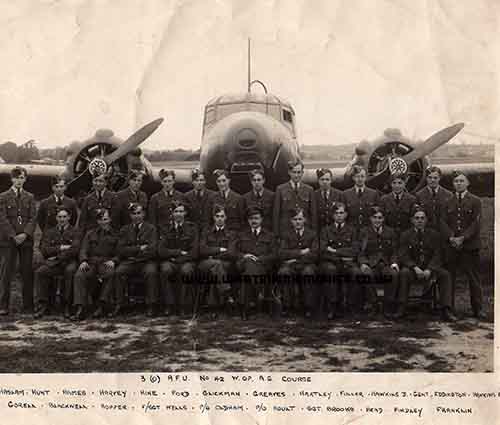 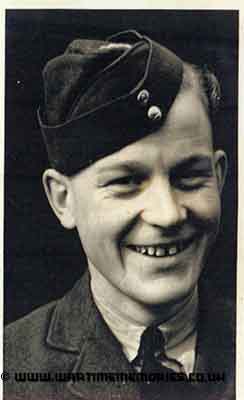 My father Henry Brooks was a lecturer during the War on Radio Operation. He taught at Cranwell, Chipping Warden and Bobbington that I know of. He wrote some stories and this is one of them:
Eventually I had to instruct all nationalities from the Empire Air Training Scheme to teach them Radio operating and theory for operating in the air. The equipment was old but one day there arrived in my laboratory a new transmitter and receiver made by Marconi. My instructions were to install it and be ready to instruct officers and staff on its uses. Within 4 hours of receiving it I gave a lecture on it. After that I instructed on it most of the time going to stations with new aircraft such as Lancasters and Halifaxes as the operational crews didn't know how to use it. In 1942 I was posted to RAF Bobbington as a Sergeant to an officers and crew training unit where the men came for training on the Marconi equipment. I have photographs of classes taken in front of aircraft whom I instructed prior to going into operations.
|
F/Lt. John Davison 104 Squadron 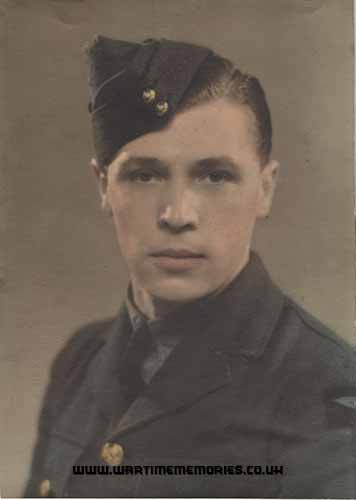 John Davison enlisted on 4 October 1940 and was trained as a Wireless Operator/Rear Gunner. He spent a long time training at Hendon, being there during the great blitz. He was then posted to Blackpool and then Yatesbury in Wiltshire. A spell at Stranraer followed on a ground station where he became a first operator and got his first real flying in a Sunderland Flying Boat.
He left Stranraer in early 1942 to go back to Yatesbury for a refresher course and then on to Evanton in north Scotland for gunnery training and he was promoted to Sergeant. He travelled from here to his home in Sunderland in August 1942 to be married. The newly married couple travelled to Barnard Castle for their honeymoon. On the first night the town had its first air raid of the war and he was recalled during the second night.
John then went to Chipping Warden for operational training, was ‘crewed up’ and was eventually posted to an overseas unit leaving England on 20 December 1943. He flew to Gibraltar and then on to Malta where he was transferred to No 104 Squadron. During his first operation on Tripoli the plane was badly shot up but returned safely; the realisation that he and his crew may not last long hit home.
The squadron moved to Egypt where John contracted jaundice and was admitted to the RAF Hospital for 3 months, rejoining the squadron near Misurata in Tripolitania. He joined a different crew here and flew many operations. They were then moved to Kairounon in Tunisia from where he completed his first tour.
The next move was to Italy where he was commissioned Acting Flight Lieutenant, Signals Leader. He completed a second tour of operations there in March 1944.
At the end of hostilities John returned to the UK landing at Liverpool on 1 April 1945. After an Assessment Board he was posted as a Briefing Officer to Transport Command and returned to Hendon for a short time. He then moved to Holmesley South in Hampshire in May 1945, where his wife Lilian was able to join him.
John’s final posting was to Waterbeach in Cambridgeshire in September 1945, where he organised the Briefing Section. He was demobbed in March 1946 and returned home to live in Sunderland.
This is from the information written down by my father before he died in 1994.
|
Sgt. James Brian Egan 12 OTU. (d.18th Apr 1945) I was talking to my mother, Edna Harris about her war experiences during the anniversary of the end of world war two. She told me about the time she spent working at Park Farm Bishopsteignton Devon. One day she said she was in the top field working horses and could see a German plane staffing a passenger train on the Teign estuary, the plane then turned towards her , she drove the horses under the trees and froze she clearly saw the pilots face and swastika as the plane turned over the farm. Her brother Edward Perkin working in the lower field jumped into a scrub full of stinging nettles. (Edward later served in the RAF as a ground engineer) The raider then carried out the next attack dropped its bomb and missed. The enemy plane was shot down by anti aircraft fire over Torbay. The pilot was seen to parachute into the sea . By coincidence Edna's sister Sylvia was coming home on leave from nursing duties, and waiting for a connection at Exeter St Davids saw the train come in to the station many carriages all shot up. I don't know of casualties. I work as a Train Driver based at Exeter I often drive between Teignmouth and Newton Abbot luckily no enemy aircraft over head but I picture the scene everytime I run the route. Mum went on to say her saddest memories are of the deaths of three relatives: Harold Vivian Perkin Hms Heckla 1942 Cape Agulas, Arthur Ernest Steel 1944 North Western Europe and James Brian Egan 1945 Chipping Warden. I realised the family had lost someone from each of the three services. Having served in the RAF from 1978 to 2000 I was interested to find out more about James Egan my mum's first cousin who used his second name Brian. Before the war mum said Brain would come down on holiday and they would often go rowing on the river Teign. She can remember how Brain would stroke on the oars and fly forward in the boat because he had not immersed them sufficiently enough into the water to get some resistance and would end up on his back with his feet in the air and the ores adrift much to the annoyance of Edward.
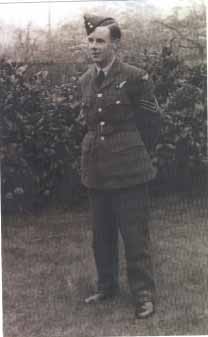 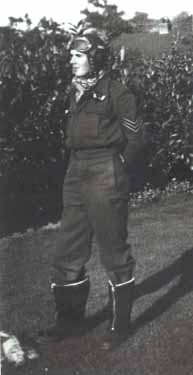 Sgt James Brian Egan.
Mum attended Brians funeral just before the war ended, an extremely sad day. Brian joined the RAF in the later stages of the war. He was training as a Wireless Operator / Air Gunner. During a training sortie 18 April 1945 on Wellington Bomber mk x LP286 the plane returned to Chipping warden following engine problems. Following an overshoot and go around the plane stalled and crashed at 14.03 into Egcote park south east of the airfield killing all but one.
- Flight Sergeant WJ Hillier -Pilot
- Sergeant H Mairs -navigator
- Sergeant AG Grant- Air Bomber
- Sergeant JB Egan - Wireless Operator
- Sergeant P McGowen- Air gunner
- Sergeant PV Birch- Air gunner (only survivor)
The crew were all aged early to mid twenties and remembered with honour.
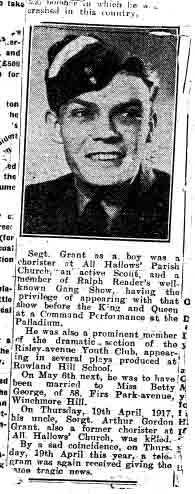 Sgt Grant.
Via the web administrator at www. aviationresearch.co.uk I made contact with a gentleman who witnessed the crash of LP 286. At the time he was a primary school boy at Chipping Warden and recalls the plane flying over with smoke trailing from the starboard engine. Following the crash the children were sent home, the crash site was near to the school boys path home. The gentleman remembers the excitement of planes flying, and at the time as a small child having no awareness to the true horror of the crash. I understand that LP286 was the last major incident at Chipping warden. I intend to try and make contact with the only survivor Sgt Birch or any relatives of him and that of the other crew members. Ultimately to place a memorial plaque at the crash site. Anyone with further information please get in touch.
|
George Francis "Chico" Robertson DFC. 9 Squadron George Robertson was born in 1918 in Lisbon to a Scottish father and Spanish mother. Schooled in Britain, he enlisted in July 1940 aged 22. He went through training then posted to 9 Squadron from 1660 HCU on 2nd February and completed 33 missions in 11 Lancasters although mainly ED499 X. He only encountered German fighter on one occasion (seen off) on 6 missions the aircraft returned with techinjcal faults (engines, oxygen, compass etc)
George was posted to 12 OTU at Chipping Warden as an Instructor on 19th of August 1943, where he was seriously injured in a motorcycle accident.
He continued his career after the war as a Port Wine Shipper with Croft & Co.
DFC gazetted 15th October 1943 - 22nd 1940 Initial Reception Centre Uxbridge
- 18th August 1940 No. 3 Initial Training Wing
- 14th November 1940 No. 15 FTS
- 13th April 1941 No. 2 CFS
- 22nd June 1942 No. 3 AFU
- 1st September 1942 No. 16 OTU
- 8th December 1942 Nos. 1654 and 1660 HCU
- 2nd February 1943 F/Lt 9 Squadron Waddington
- 19th August 1943 posted to No. 12 OTU Chipping Warden as Instructor after completing 33 mission tour
- 5th April 1944 Dangerously injured in motorcycle crash at the airfield. 30% disability.
|
Sgt. Arthur John Pickering Stamper 7 Squadron 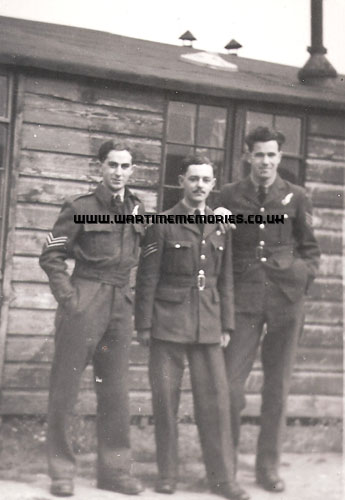 My father, John Stamper was a navigator. Having trained in Florida, USA and at RAF Waterbeach on Wellingtons, he moved on 19th of Februaru 1943 to 1651 Conversion Unit at Waterbeach on Stirlings Mk1, and to new satellite aerodrome at Turweston. Training included night flying. It would appear, that this was training for Pathfinder duties, not standard bombing.
The original crew were Sgt Petrie Pilot from New Zealand,
Sgt Stamper Navigator,
Sgt Rose Bomb Aimer,
Sgt Edmonds Wireless Operator,
Sgt Seery Rear Gunner from Australia
Sgt Hartshorne Flight Engineer and name not remembered of the Mid-upper Gunner.
Total day flying at Waterbeach etc 11 hrs 50 mins, night 1.30 [I think these figures by dad way off as total flying hours in training 194 hr 45 mins. Above it says he did 97 hrs 30 mins at Chipping Norton. This leaves almost 100 hours unaccounted for, which seems a more likely total for training on Stirlings at Waterbeach.
Apparently dad told mum that they were lined up to convert to Lancasters in the near future, presumably with 7 Squadron, this transfer happened in May 1943. Stirlings were generally withdrawn from front-line duties in late 1943.
At some stage in his training dad was involved in testing one of the versions of the Gee radar system, which was upgraded and refined after its introduction in 1941 or 42. Dad told me that on one occasion with some high-level observer(s) on board he had to locate the chapel of King's College very precisely.
On 26th of March 1943, apparently the last day before operational flying was due to start with the Stirlings, the undercarriage collapsed on take off on a dummy bombing run on Hull. Cross-country runs typically preceded operational flying. Dad banged his head badly, and ended up with his feet tangled in the wiring. He performed a difficult, panicked exit from the plane, with the danger of fire.
He suffered headaches and with no flying for six weeks, he was working in the navigation office and saw some sort of personnel file where he'd been recommended for promotion to Pilot Officer. But he had been ticked off by the station Commander for nosing around in his paperwork. It is not known what happened to the recommendation.
The log book suggests he left Waterbeach on 25th of May 1943. In all (according to his maths), he had flown 194 hours 45 mins while training in England.
Then he spent three months in Northfield Military Hospital, Birmingham. Mum remembers him saying that after the crash he was too shaken even to get on a bus as that involved leaving the ground. Northfield was famous for its pioneering psychiatric work on RAF patients in Second World War. Then there was a stint at the War Office Officer Assessment at Catterick, involving assault courses etc.
He didn't feel he had any aptitude for leadership, as he was too young and green, and was still dicky from the crash. He was transferred to Royal Signals and served in the War Rooms under Whitehall, and later at Droitwich, on wireless signalling.
Sgt Petrie, and others from dad's crew, were shot down and killed flying a Pathfinder Lancaster six months later, on night of 16th/17th of December 1943.
|
Recomended Reading.Available at discounted prices.
|
|
|













